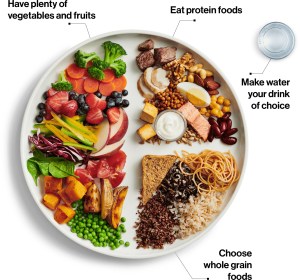How the CFG Could Change the Dairy Industry
Canada’s Food Guide was first released in 1942 as a tool to help Canadians stay healthy and prevent nutritional deficiencies while under wartime food rations. Over the years, the CFG and its definition of what constitutes a healthy diet – has transformed many times.
The Canadian Food Guide builds its official guidelines through a variety of scientific research, the opinions of medical experts and the most up-to-date studies. As more and more information and studies are produced, the contents of that guide evolve and transform.
Other factors that have historically influenced the precise contents of the CFG vary from the scarcity of particular foods – such as milk in 1944 – to the direction Canada was taking food production at the time. Industry lobbying and political wrangling provoked mistrust in the 70s and 80s, where many citizens questioned the legitimacy of CFG and how much of it was influenced by Big Food. Back to the 1942 edition, a high emphasis on fats and proteins were incorporated because the government needed to fatten up Canadian soldiers fighting in World War II.
Before now, the last revision of Canada’s Food Guide was released in 2007 – and the 2019 version looks quite different. Many are asking, is today’s guide finally accurate?
The official recommendation encourages:
- Fruits and Vegetables (sweet potatoes, tomatoes, spinach, strawberries, apples, etc)
- Protein Foods (nuts, beans, meat, fish, eggs)
- Whole Grain Foods (pasta, rice, quinoa, bread)
- Water as your drink of choice

There are many different interpretations behind the meaning of this year’s edition. Some are arguing that CFG has completed dismissed the significance of meat and dairy products, and are worried about the implications long-term.
Will meat and dairy have a place in the future of Canadian food?
Some of the facts that need to be considered, begin with noting: Canada’s Food Guide does not discredit meat and dairy products. Instead, it has made room to include plant-based diets. It also has moved away from whole grain foods and sugar high items.
Sugary and fat-heavy diets have caused a shift in Canadian’s health. Obesity rates are at an all-time high in Canada with 64% of Canadians over the age of 18 classified as overweight.
The truth is, a lot of individuals eat far too much fatty meats and excessive amounts of dairy. Balancing plant-based protein consumption with dairy and meat intake can actually have a really good impact on overall energy levels and health. Meat and dairy are not the enemy: overindulgence is.
Food production industries may feel the sting of these changes to Canada’s Food Guide in the coming years – but meat dairy, meat, and refined grains won’t be going anywhere anytime soon.
To learn more, visit: https://food-guide.canada.ca
Sources:
https://www.canada.ca/en/health-canada/services/canada-food-guide/about/history-food-guide.html
https://www.cbc.ca/news/business/new-food-guide-meat-dairy-industries-1.4988632










